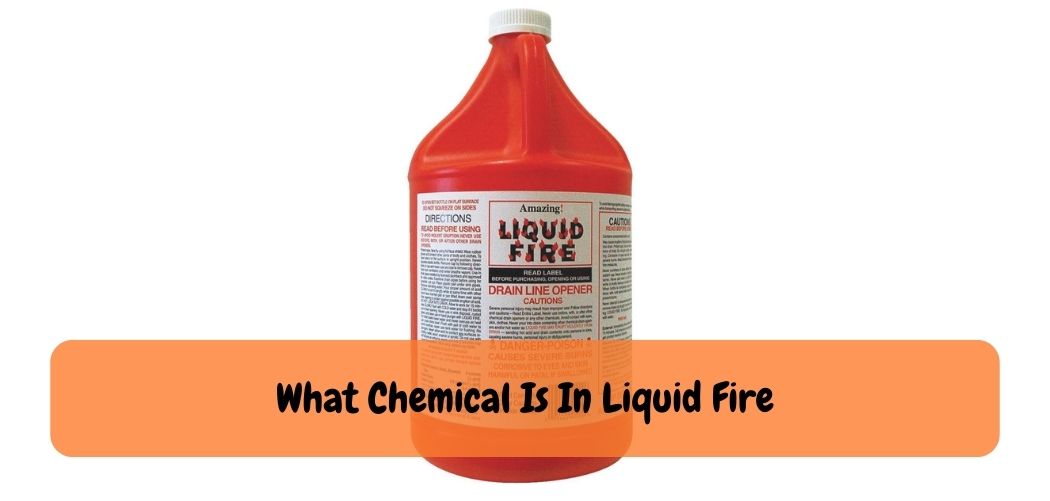The chemical in liquid fire is sulfuric acid. Liquid fire is a powerful drain cleaner that is used to clear clogs in sinks, toilets, and other plumbing fixtures.
In the realm of chemical marvels, few substances capture the imagination as intensely as “liquid fire.” This enigmatic solution possesses an innate ability to ignite, blaze, and consume with unparalleled ferocity. But what exactly is the chemical composition that grants it such incendiary prowess?
In this exploration, we delve into the intricate world of liquid fire, dissecting the elements that orchestrate its combustive dance. From the ancient alchemical origins to its modern-day applications, we unveil the science and mystery behind.
This captivating concoction, revealing the transformative power that arises from the careful interplay of its components. Join us on a journey through the flames as we demystify the chemistry that fuels the phenomenon of liquid fire.
The Dangerous Truth About Liquid Fire: What You Need To Know
Liquid fire is a popular industrial cleaning solution that is known for its potency and effectiveness in dissolving grease, oils, and other stubborn substances. Although it is used widely in various industries, very little is known about its chemical composition and potential hazards.
The main ingredient in liquid fire is sodium hydroxide, which is a highly caustic and corrosive chemical capable of causing severe burns and tissue damage upon contact with the skin and eyes. The application of liquid fire requires strict adherence to safety protocols and the use of protective gear to prevent.
Accidental exposure and injuries. It is crucial to store and handle liquid fire carefully to avoid spills, leaks, and other potential hazards. In the event of accidental exposure, immediate medical attention is necessary to reduce the risk of severe injury or death.
The Smart Guide For: Chemical Is In Liquid Fire
When it comes to substances that command both fascination and caution, few can match the intensity of “liquid fire.” The term itself conjures images of blazing infernos and fiery spectacle. But what exactly is this incendiary substance.
What chemicals are responsible for its intense combustion? In this comprehensive guide, we will unravel the intricate chemistry behind liquid fire, exploring its components, properties, and applications.
Table of Contents:
1. Introduction to Liquid Fire
Defining Liquid Fire
Historical Context and Uses
2. Chemical Components of Liquid Fire
Hydrocarbons: The Basis of Combustion
Oxidizers: Igniting the Blaze
Stabilizers and Modifiers: Controlling the Reaction
3. The Combustion Process
Chain Reactions and Exothermic Releasing
Heat Generation and Emission of Light
4. Varieties of Liquid Fire
Napalm: The Infamous Weapon
Gel Fuels: Controlled Combustion
Entertainment Pyrotechnics: Controlled Explosions
5. Applications and Safety Considerations
Military and Tactical Use
Controlled Burning for Land Management
Pyrotechnics in Entertainment
Safety Measures and Precautions
1. Introduction to Liquid Fire: Liquid fire is a term that encompasses a range of flammable substances known for their remarkable combustion properties. Historically, these substances have been utilized in warfare.
controlled burning, and pyrotechnics. From Greek fire in ancient times to modern-day applications, liquid fire has captivated both the imaginations of alchemists and the strategic minds of military tacticians.
2. Chemical Components of Liquid Fire:
- Hydrocarbons: Liquid fire typically consists of hydrocarbons, which are organic compounds composed of hydrogen and carbon atoms. These hydrocarbons serve as the fuel source for combustion reactions.
- Oxidizers: Liquid fire also contains oxidizers, compounds that release oxygen atoms during their decomposition. These oxygen atoms facilitate the rapid oxidation of the hydrocarbons, leading to the release of energy in the form of heat and light.
- Stabilizers and Modifiers: To control the rate of combustion and enhance the stability of the mixture, stabilizers and modifiers may be added. These substances ensure that the combustion process is consistent and controlled.
3. The Combustion Process: Combustion is a chemical reaction between a fuel and an oxidizer, releasing energy in the form of heat and light. In the case of liquid fire, hydrocarbons react with oxygen from the oxidizers, initiating a chain reaction that produces intense heat, flames, and often a plume of dense smoke.
4. Varieties of Liquid Fire:
- Napalm: A notorious variant of liquid fire, napalm is a mixture of a gelling agent and petroleum, often used as a weapon due to its ability to stick to surfaces and create devastating fires.
- Gel Fuels: These are engineered liquid fire formulations use in controll environments, such as controlled burns for land management and fire shows.
- Entertainment Pyrotechnics: Liquid fire finds a creative outlet in pyrotechnics, contributing to spectacular fire displays in entertainment events.
5. Applications and Safety Considerations:
- Military and Tactical Use: Napalm and similar incendiary mixtures have been use in warfare to clear vegetation, deny resources, and cause destruction.
- Controlled Burning for Land Management: Gel fuels can use to manage vegetation in a controlled manner, reducing the risk of uncontrolled wildfires.
- Pyrotechnics in Entertainment: Liquid fire is a crucial element in creating dazzling fire-based visual effects for performances and events.
- Safety Measures and Precautions: Due to the inherent danger of uncontrolled combustion, strict safety protocols and regulations are essential when handling liquid fire. Proper storage, transportation, and usage guidelines must be adher to.
Also Read: How Strong is Liquid Fire? Exploring Its Potency
The Impact Of Liquid Fire Chemicals On Health And The Environment
Liquid fire is a powerful drain cleaner use in industrial and household applications. Health risks are pose the present in liquid fire, which can cause acute and chronic toxici. Exposure to these chemicals can also have long-term health effects.
Making it essential to use safer alternatives to liquid fire. Environmental consequences of liquid fire use and disposal can harm soil, water, and air quality. Fortunately, eco-friendly, non-toxic solutions are available that can use instea of liquid fire.
These sustainable alternatives offer many benefits, including improved safety, cost-effectiveness, and reduced environmental impact. By introducing these safe options, we can minimize the risks associated with liquid fire and protect our health and the environment.
Frequently Asked Questions Of What Chemical Is In Liquid Fire?
What Is Liquid Fire And How Does It Work?
Liquid fire is a drain opener containing a mixture of sulfuric acid and surfactant. When poured into a clogged drain, it creates heat and an exothermic reaction that clears the blockage.
Can Liquid Fire Cause Harm To Skin And Eyes?
Yes, liquid fire is highly corrosive and can cause severe burns if it comes in contact with skin or eyes. It is crucial to wear protective clothing and glasses when using it and to keep it out of reach of children and pets.
Is Liquid Fire Safe To Use On All Types Of Materials?
No, liquid fire can damage some materials such as plastic, rubber, and metals. It is best to check the manufacturer’s instructions before using it. Avoid using it on disposals or toilets as it can cause damage.
How Long Does It Take For Liquid Fire To Work?
Liquid fire typically works within a few minutes of being poure down a clogg drain. However, for stubborn blockages, it may take up to 30 minutes to dissolve and remove the obstruction.
Can Liquid Fire Be Used To Prevent Drain Clogs?
No, liquid fire is not a preventative measure and should only use to clear clogs. To prevent drain clogs, it is important to avoid pouring grease, hair, and other debris down the drain and to use a drain catcher to trap any large particles.
Conclusion
Overall, it’s clear that liquid fire is an incredibly potent household drain cleaner that contains hydrochloric acid. While other drain cleaners may contain other types of acids or bases, hydrochloric acid is the active ingredient in this particular product. It’s important to use caution when handling this powerful chemical, as it can cause severe burns and damage to skin and eyes.
Additionally, it’s crucial to only use this product as instructed and to avoid mixing it with other chemicals, as this can lead to dangerous reactions. While liquid fire may not be the safest or most eco-friendly option for clearing clogs and obstructions, it can certainly be effective when used correctly.
It’s important to weigh the pros and cons and make an informed decision based on individual needs and preferences. Overall, liquid fire serves as a stark reminder of the importance of proper chemical handling and education.










